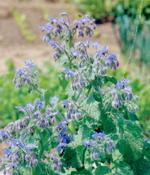| Fruits |
Vegetables
|
Borage, Borago officinalis / Boraginaceae
|
Note: Composition for 100 g. of fresh product Values in ( min. - max. ) format. | |
| Energy: 17 kcal Fats: 0.7 g | Proteins: 1.8 kcal Carbohidrates: 1.1 g |

Borage is a scarcely cultivated plant, although it is highly appreciated in some areas. Its leaves and stems are consumed raw or cooked. The flowers are preferred as seasoning. It has various medicinal properties, for which the leaves and flowers are used.
Nutrition and eating
For many years, borage has been intended for medicinal purposes, using both the leaves as the flowers. It is thought to be diuretic, diaphoretic, anti-inflammatory and depurative, among other qualities. The application varies from poultices to infusions or juices.
The fruit
 Borage is a scarcely cultivated plant, although it is highly appreciated in some areas. Its leaves and stems are consumed raw or cooked. The flowers are preferred as seasoning. It has various medicinal properties, for which the leaves and flowers are used.
Borage is a scarcely cultivated plant, although it is highly appreciated in some areas. Its leaves and stems are consumed raw or cooked. The flowers are preferred as seasoning. It has various medicinal properties, for which the leaves and flowers are used.Borage grows as a wild plant in many places, like the side of the roads, hedges or in not very high mountainous regions. In some areas it is highly appreciated and widely cultivated. At present, it is cultivated in Europe, although it is not an extended culture. In Spain it is produced at local level, in La Rioja and Aragón, where it is highly appreciated.
The plant shows some turgid, cylindrical and thick stems, with large leaves of greyish green colour. The leaves, the stems and the flowers are all of them consumed. The first two are consumed raw or cooked, whereas the minced flowers and leaves are mainly used to garnish salads and other dishes. It is bought fresh or frozen.
It has a very low energetic value, therefore it can be consumed by people following diets. It provides with vitamin A and C and some minerals like iron and potassium. From the very old times, their leaves and flowers have been given medicinal properties.
The plant
Borage belongs to the family of Boraginaceae; its scientific name is Borago officinalis. It is an annual rustic plant, 30-50cm high, that forms a rosette of oblong leaves covered with prickly hair. The peduncles are long and fleshy, being the edible part of the plant. The stems are erect, cylindrical and thick.
The flowers are white or slightly bluish, with five pointed petals. During flowering, it cannot be marketed, since the plant looses its commercial value.
The flowers are white or slightly bluish, with five pointed petals. During flowering, it cannot be marketed, since the plant looses its commercial value.
| Interempresas Media, S.L. / 2025 | [ Legal notice | Política de Protección de Datos | Política de cookies | Publicidad] |
